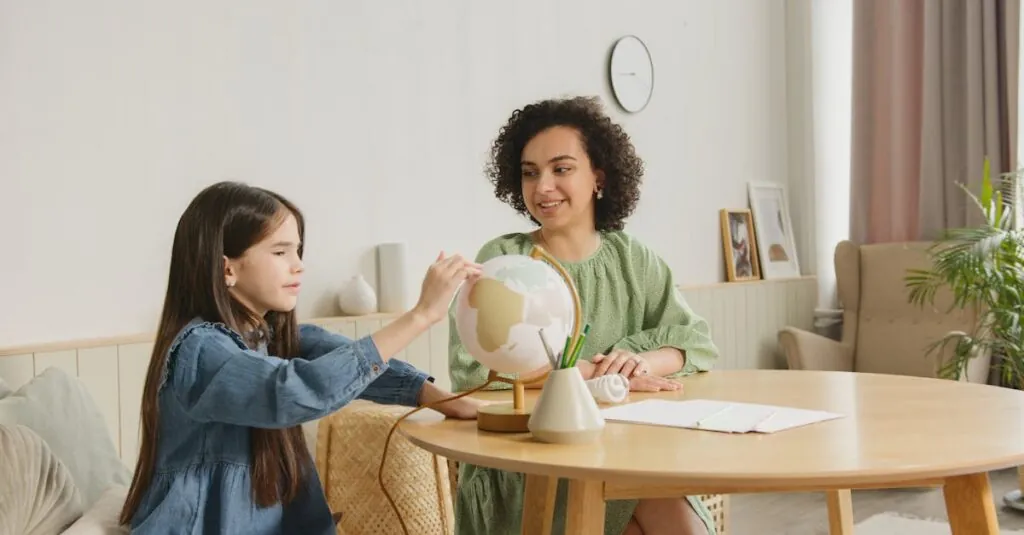Table of Contents
ToggleCuriosity might just be the secret sauce to a fulfilling life. Picture this: a world where asking “why” isn’t met with eye rolls but with excitement and exploration. It’s not just for kids; adults can benefit from channeling their inner five-year-olds. After all, who wouldn’t want to unlock new ideas and experiences just by embracing a little curiosity?
The Importance of Encouraging Curiosity
Curiosity plays a crucial role in personal development and lifelong learning. Embracing curiosity fosters creativity and critical thinking in individuals. It allows people to question their surroundings and pursue knowledge actively. Asking questions opens doors to new ideas and perspectives.
Adults often overlook their innate curiosity, which leads to missed opportunities for growth. Recognizing this tendency is vital for individuals wishing to cultivate an inquisitive mindset. Engaging with diverse subjects enhances understanding and encourages exploration.
Curiosity promotes problem-solving skills, making individuals more adaptable in various situations. Studies show that curious individuals are more likely to find effective solutions and innovate in their fields. They tend to explore uncharted territories, leading to new discoveries.
Furthermore, curiosity strengthens emotional intelligence by facilitating deeper connections with others. Approaching conversations with a mindset geared toward learning can enhance communication skills. In turn, improved communication skills foster collaboration and teamwork.
Encouraging curiosity not only benefits individuals but also has a positive impact on communities and organizations. Companies that nurture curiosity in their employees often see increased creativity and productivity. These workplaces thrive on innovation and adaptability, qualities essential in today’s fast-paced world.
Overall, actively promoting curiosity leads to brighter futures. Individuals, organizations, and communities benefit significantly from embracing this essential trait.
Strategies for Encouraging Curiosity
Encouraging curiosity involves implementing effective strategies that create an environment conducive to exploration and questioning.
Fostering a Supportive Environment
Creating a supportive environment plays a pivotal role in sparking curiosity. Spaces that encourage open-mindedness promote exploration. Providing access to diverse resources can stimulate interest, allowing individuals to discover new topics. Encouragement from peers and mentors enhances motivation, leading them to ask questions. Recognition of curiosity fosters a sense of safety in expressing thoughts. Integrating collaborative activities can inspire curiosity as well, allowing individuals to learn from one another’s perspectives. Ultimately, a nurturing environment cultivates a continuous desire to explore.
Asking Open-Ended Questions
Open-ended questions serve as powerful tools for stimulating curiosity. Such questions invite thoughtful responses rather than simple yes or no answers. Inquiry like “What do you think about…?” encourages deeper reflection and personal interpretation. This approach prompts individuals to think critically about subjects and express their ideas. Emphasizing the importance of inquiry can lead to richer conversations and engagement. Open-ended questions not only promote exploration but also enhance communication skills. Encouraging this practice builds a habit of curiosity that lasts a lifetime.
The Role of Encouraging Curiosity in Education
Encouraging curiosity plays a key role in education, enhancing both engagement and understanding.
Engaging Learning Activities
Schools increasingly incorporate interactive learning activities to spark curiosity among students. Hands-on experiments complement theoretical knowledge, nurturing a deeper understanding of concepts. Project-based learning fosters teamwork and creativity, as students explore real-world problems. Field trips offer experiential learning opportunities, connecting classroom lessons to practical applications. By using technology, educators create immersive experiences that captivate students’ imaginations. Activities that incorporate games allow for enjoyable learning while stimulating curiosity. Engaging students through diverse methods ensures a dynamic educational environment that promotes exploration.
Promoting Critical Thinking
Critical thinking skills flourish in environments that encourage curiosity. Educators can implement discussion-based classes, prompting students to analyze and evaluate information actively. They often incorporate debates where students defend their viewpoints, enhancing analytical skills. Open-ended questions challenge students to articulate their thoughts and consider multiple perspectives. By promoting independent research projects, educators empower students to pursue inquiries that matter to them. The freedom to explore unique topics fosters personal investment in learning. Ultimately, critical thinking emerges naturally when curiosity thrives within educational settings.
Encouraging Curiosity in Children
Fostering curiosity in children is essential for their development and learning. Parents and educators can actively cultivate curiosity through effective techniques.
Techniques for Parents and Educators
Creating an engaging environment significantly boosts children’s curiosity. Parents can ask open-ended questions that inspire children to think critically. Educators might incorporate hands-on activities that promote exploration. Encouraging play, such as role-playing or building with blocks, sparks imaginative thinking and discovery. Providing access to a variety of books and resources also invites children to explore new topics actively. Celebrating their questions and discoveries reinforces their desire to learn more. Using field trips as opportunities for exploration deepens their understanding and helps connect lessons to real-world experiences.
The Impact on Child Development
Curiosity plays a vital role in child development. It enhances cognitive skills, enabling better problem-solving abilities. Research shows that curious children tend to perform better academically due to their eagerness to learn. They develop social skills, as asking questions can lead to deeper conversations with peers. Emotional intelligence also grows when children engage in explorative play, allowing them to understand different perspectives. Overall, nurturing curiosity supports holistic development, laying the foundation for lifelong learning and adaptability in ever-changing environments.
Encouraging Curiosity in the Workplace
Cultivating curiosity in the workplace enhances overall engagement and innovation. When employees explore new ideas freely, the organization can thrive.
Nurturing Innovation and Creativity
Creativity flourishes in environments that support curiosity. Employees empowered to ask questions develop innovative solutions. Companies can introduce brainstorming sessions to stimulate diverse perspectives. Encouraging collaboration among teams fosters an exchange of ideas, leading to unique concepts. Providing resources, such as workshops and training, can ignite passion for exploration. Empowering employees to pursue their interests aligns personal inspiration with organizational goals.
Benefits of a Curious Workforce
A curious workforce enhances problem-solving capabilities significantly. According to studies, curious individuals adapt more readily to changes. Increased adaptability leads to quicker responses to challenges. Collaboration improves as curiosity drives communication across departments. Higher engagement results from individuals feeling valued for their input. Companies that promote curiosity often experience greater employee satisfaction and retention. Overall, cultivating curiosity in the workplace not only boosts creativity but also supports a cohesive organizational culture.
Embracing curiosity opens doors to endless possibilities and growth. By nurturing this innate trait individuals can enhance their creativity and critical thinking skills while fostering deeper connections with others. Whether in education or the workplace encouraging curiosity leads to richer experiences and innovative solutions.
Creating environments that support exploration and questioning is essential for personal and communal development. As curiosity flourishes both individuals and organizations can thrive in today’s dynamic world. Ultimately a commitment to curiosity not only enriches lives but also cultivates a culture of continuous learning and adaptability.







